Roy K.K. Potential theory in applied geophysics
Подождите немного. Документ загружается.

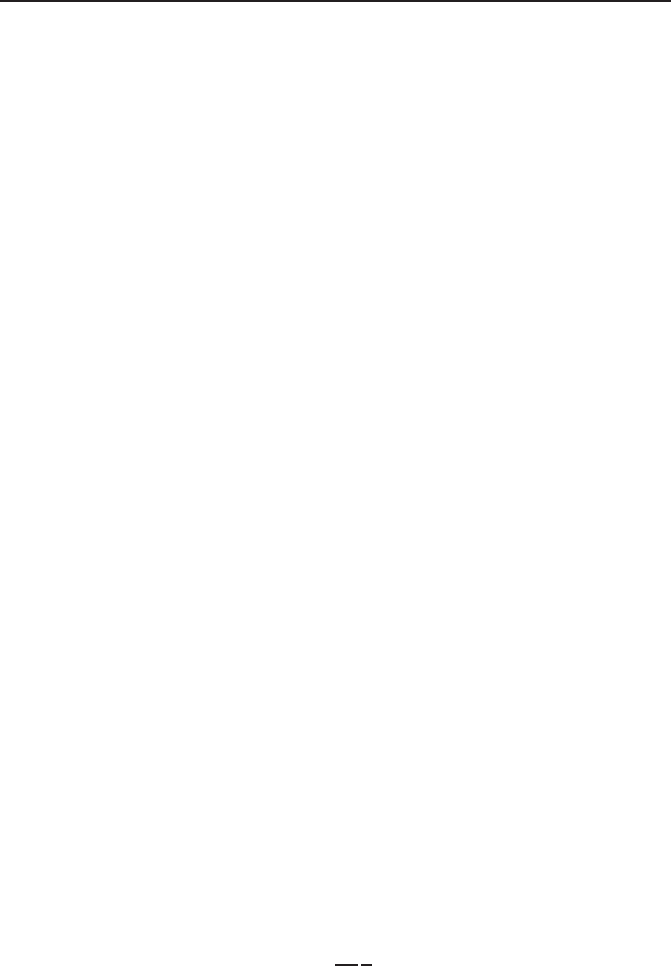
11
Electrical Images in Poten tial Theory
In this chapter a brief idea about the concept of electrical image and its use in
computation of p erturbation potential in direct current flow field for layered
earth structures in bore hole geophysics are demonstrated. Necessary formulae
for computation of potentials a cross a horizontally stratified 3 layered bed
are given for two, three and seven(laterolog-7) electrode configurations. Th i s
approach for solution of the boundary value problems is restricted to problems
with simpler geometries.
11.1 Introducti on
Many of the potential problems in direct current p otential domains can be
solved using the concept of images. The analogy is drawn from optics. It
is shown that using more than one reflector one can get several series of
images, the way one gets the optical images in between the two mirrors. The
only condition required to satisfy is potentials must be continuous across the
boundary (or reflector). This technique for computation of potential is only
valid for plane boundaries (Dakhnov (1962), Keller a nd Frischknecht (1966).
Concept of images with spherical boundaries are available in. (Ramsay 1940),
Macmillan (1958).
11.2 Computation of Potential Using Images
(Two Media)
The potential at a point at a distance ‘r’ from a point current source embedded
in an infinite and homogeneous medium of resistivity ‘ρ’isgivenby
φ =
Iρ
4π
1
r
(11.1)
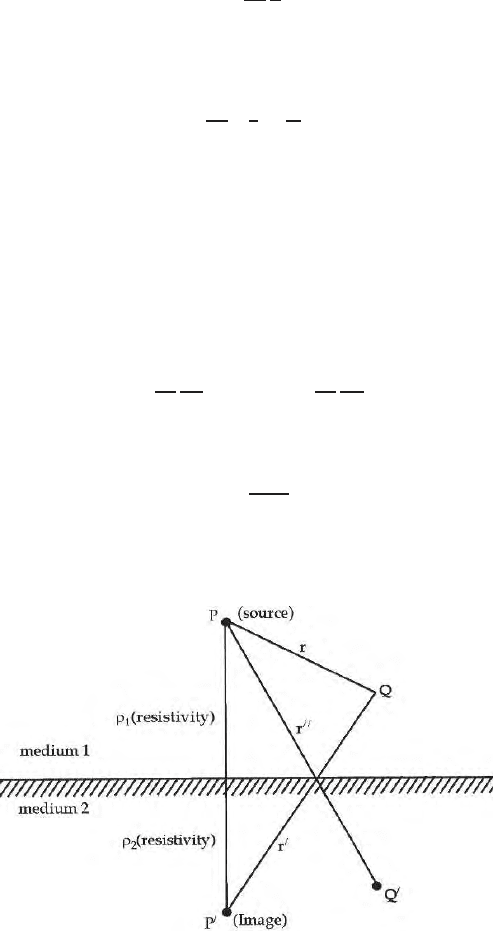
330 11 Electrical Images in Poten tial Theory
where I is the current flowing through the medium. In a semiinfinite medium
when the current electro de is on the surface,
φ =
Iρ
2π
1
r
. (11.2)
For two homogeneo us and isotropic semiinfinite media of resistivity ρ
1
and ρ
2
(Fig. 11.1) the p otential at a point P due to current source I is
φ =
ρ
1
4π
I
r
+
I
′
r
′
. (11.3)
Here I’ is termed as the electrical image of I at P. P and P
′
are at a same
distance from the boundary of the two media of resistivity ρ
1
and ρ
2
.Some
analogy can be drawn from the theory o f optics. This perturbation term,
originated from the concept of image and has to satisfy the basic boundary
conditions in direct curr ent electrical method i.e., (i) the potential on both
the media must be same on th e boundary and (ii) the normal component of
the current density is continuous across boundary.
These boundary conditions are φ
1
= φ
2
and
J
1
=
1
ρ
1
∂φ
∂n
1
=J
2
=
1
ρ
2
∂φ
∂n
2
. (11.4)
Potential in a medium 2 due to a current source in a medium 1 is given by
φ
2
=
ρ
2
I
′′
4πr
′′
(11.5)
where I
′′
is the reduced current strength and r
′′
is the distance of the point of
observation in the medium 2 from the source I in the medium 1.
Fig. 11.1. Electrical Image for a plane single b oundary between two semi infinite
media of resistivity ρ
1
and ρ
2
respectively
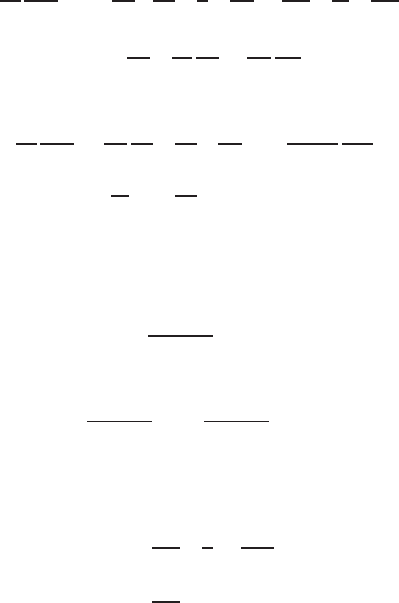
11.2 Computation of Potential Using Images (Two Media) 331
In order to determine the strengths of the fictitious current, we shall
apply the boundary conditions stated above. At the boundary since r = r
′
(Fig. 11.1), we get
ρ
1
(I + I
′
)=ρ
2
I
′′
. (11.6)
Applying the second boundary condition, we get
1
ρ
1
∂φ
1
∂n
1
=
1
4π
∂
∂r
I
r
∂r
∂n
+
∂
∂r
′
I
′
r
′
∂r
′
∂n
= −
1
4π
I
r
2
dr
dn
+
I
′
r
′2
dr
′
dn
(11.7)
and
1
ρ
2
∂φ
2
∂n
=
1
4π
∂
∂r
I
′′
r
′′
dr
dn
= −
I
′′
4πr
′′2
dr
′′
dn
. (11.8)
A t the boundary r = r
′
and
dr
dn
= −
dr
′
dn
. Equating (11.7) and (11.8), we get
I −I
′
=I
′′
. (11.9)
Equations (11.6) and (11.9) yields
I
′
=
ρ
2
− ρ
1
ρ
2
+ ρ
1
I=K
12
I (11.10)
and
I
′′
=
1 −
ρ
2
− ρ
1
ρ
2
+ ρ
1
I
=
2ρ
2
ρ
1
+ ρ
2
I=(1−K
12
)I. (11.11)
K
12
and (1−K
12
) a re termed respectively as reflection factor and transmission
factor. Potentials in the first and second media ar e respectively given by
φ
1
=
ρ
1
I
4π
1
r
+
K
12
r
′
(11.12)
φ
2
=
ρ
2
I
4π
(1 − K
12
) . (11.13)
We can now compare electrical images with o ptical images. Current source
should be replaced by a source of light and boun d ary between the two media
should be replaced by a mirror of reflection coefficient K
12
and transmission
coefficient (1−K
12
). If the light source is seen from medium 1, one can measure
the intensity of light due to the source and the reflected light intensity I
′
and
coming from the image point P
′
. I f the light source is viewed from medium 2,
one will see the light with reduced intensity (1 − K
12
)I.
332 11 Electrical Images in Poten tial Theory
11.3 Computation of Potential Using Images
(for Three Media)
A simple approach for computing potential field using the theory of electrical
images is discussed. The use of images, has major application in plane bound-
ary problems. Concept of image can also be applied for spherical boundary
problem. The potential field can be found out very easily for a medium with
two plane and parallel boundaries using this method. The problem is one of
determining the potential function for three regions designa t ed as medium
1,2and3havingresistivitiesρ
1
, ρ
2
and ρ
3
. The regions are separated by two
plane parallel boundaries P and Q (Fig. 11.2). The general set up and the
po sition of the different series of current images and their strengths, when
the current source is situated in medium 1 at a point A, are shown In the
Fig. 11.2. Here H is the thickness of medium 2, the target bed, Z, is the dis-
tance of the current electrode from the interface P, between medium 1 and 2
; D, is the distance between the current and potential electrodes. K
ij
is the
reflection factor for medium i and j, where K
ij
=(ρ
j
− ρ
I
)/(ρ
j
+ ρ
I
),iandj
varies between 1 2 and 3 and I is the current strength. For determining the
potential at a point, we have to first find out the potential at a point due to
the source irrespective of whether the source and the observation point (s) are
in the same or in different medium (or media). Next the contributions from
series of images are computed and are algebraically added up.
Distribution of image current sources in a medium with two parallel plane
boundaries; the original current source A [I] in medium 1 are shown in the
Fig. (11.2). These series of images originated to satisfy the two boundary
conditions at the interfaces, i.e.,
1) φ = φ
′
2) J
n
=J
′
n
where φ and φ
′
are the potentials and J
n
and J
′
n
are the normal components of
the current densities on both the sides of the interface. More than one series
of images are generated for any current source placed in any medium.
Any current source placed in medium 1 at a distance z from the interfac e P
has to satisfy the boundary conditions at P. By introducing the image source
A
1
(2)
of strength IK
12
the boundary condition at P is satisfied. The potential
function in medium 2 will be the same as it would be in a fully infinite and
homogeneous medium with a source of re du ced intensity I(1 −K
12
).
Now, to satisfy the boundary condition at Q, another fictitious current
source A
1
(3)
in medium 3 at a distance 2 (H + Z) from the current source at
A has to be introduced. The strength of this source will be 1(1 − K
12
)K
23
.
Addition of this second fictitious source in dicates that the boundary con-
ditions at P is no longer valid. A third image at the point A
1
(1)
in the first
medium is needed to satisfy the boundary conditions. The strength of the
image source will be I (1 − K
12
)K
21
K
23
and located at a distance 2(2H + Z)
from the image A
1
(3)
in the third medium and 2H from the original current

11.3 Computation of Potential Using Images (for Three Media) 333
Fig. 11.2. Shows the formation of images in a layered medium
source A. When the addition of third image A
1
(1)
satisfy the boundary con-
ditions at P, the boundary conditions at the interface Q becomes invalid. To
restore this, another image source A
2
(3)
of strength I(1 − K
12
)K
23
K
21
K
23
has to be introduced in the third medium at a distance 2(2H + Z) from the
original current source at A.
The process of developing image sources will co ntinue infinitely for bal-
ancing out the proceeding boundary condition. This process will create two
infinite series of image sources one in medium 1 and other in medium 3.
In medium 1, the generalized expression of the image current source are
I(1 − K
12
)(K
21
K
23
)
n
and are located at a distance 2nH from the original
current source at A and in medium 3, the expression of image current sources
are I(1 − K
12
)K
23
(K
21
K
23
)
n−1
at a distance of 2(nH + Z) from the source
current. Dep ending on the position of the electrodes current image sources are

334 11 Electrical Images in Poten tial Theory
used for calculation of potentials. For example if potential current electrodes
are in medium 1 , the images in medium 1 are not considered.
Proceeding in a same way, it can be shown that if we have a current
source in medium 2 , then there will be four series of images. Considering a
point source electrode at a distance Z from the interface P, the generalized
expressions for image sources are described below.
a) First series of images in the medium 1 with strength IK
21
(K
21
K
23
)
n−1
at
a distance 2(n − 1)H + Z from the current source.
b) Second series of images in the medium 1 with strength I(K
21
K
23
)
n
at a
distance 2nH from the current source.
c) First series of images in the medium 3 with strength IK
23
(K
21
K
23
)
n−1
at
a distance 2(nH − Z) from the original current source.
d) Second series of images in the medium 3 with strength I(K
21
K
23
)
n
Proceeding in the similar way, expression for image sources when the cur-
rent electrode is in medium 3 can be found out. In the following section a
set of general expressions of potentials are given considering one current and
one potential electrode. They cover all possible combination that can appear
considering two electrodes and three media with two parallel boundaries.
11.4 General Expressions for Potentials Using Images
To generate these expressions for potentials we have taken a 3 layered earth
model with upper shoulder bed resistivity ρ
1
(medium 1), target bed resistivity
ρ
2
(medium 2) and lower shoulder bed resistivity ρ
3
(medium 3) ; H is the
target bed thickness, distance of current electrode z is calculated from the
interface between medium 1 and medium 2, when the current electrode is
in the medium 1. The distance z is also calculated from the interface of the
medium 2 and medium 3 when the current electrode is in the medium 3, D
is the electrode separation, K
12
, K
23
, K
21
are the reflection coefficients where
K
12
=(ρ
2
−ρ
1
)/(ρ
2
−ρ
1
)andK
23
=(ρ
3
−ρ
2
)/(ρ
3
+ ρ
2
) and I is the current
sent. In some expressions ± sign is given. This is due to the relative positions
of the electrodes in a particular medium. Basic equation for calculation of
potential measured at the borehole axis (r = 0) due to one point source
current electrode can be written as follows.
a) Expressions of potential at a point when both the electrodes are in
medium 1
φ
1
1
=
ρ
1
I
4π
)
1
D
+
K
12
(2Z ± D)
+(1− K
12
)K
23
∞
n=1
(K
21
K
23
)
n−1
(2nH + 2Z ± D)
*
(11.14)
b) Expression of potential at a point when the current electrode is in mediu m
1 and the potential electrode is in medium 2
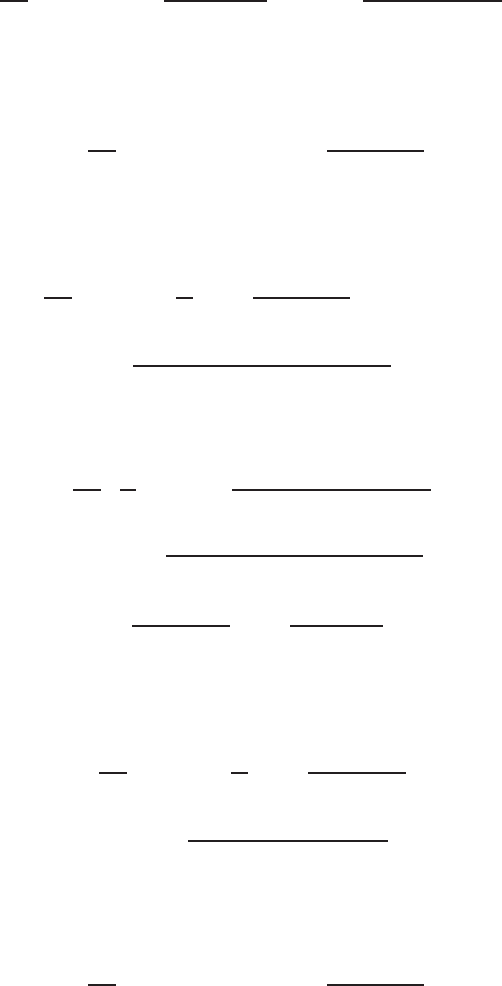
11.4 General Expressions for Potentials Using Images 335
φ
1
2
=
ρ
2
I
4π
(1 −K
12
)
)
∞
n=0
(K
12
K
23
)n
(2nH + D)
+K
23
∞
n−1
(K
21
K
23
)
(2nH + 2Z −D)
*
(11.15)
c) Expression of potential at a point when the current electrode is in medium
1 and the potential electrode is in medium 3
φ
1
3
=
ρ
2
I
4π
(1 −K
12
)(1− K
23
)
∞
n=0
(K
21
K
23
)
n
2nH + D
(11.16)
d) Expression of potential at a point when the current electrode is in mediu m
2 and the potential electrode is in medium 1
φ
2
1
=
ρ
1
I
4π
(1 − K
21
)
)
1
D
+
∞
n=1
(K
21
K
23
)
n
(2nH + D)
+K
23
∞
n=1
(K
21
K
23
)
n−1
{2(n− 1) H + 2 (H − Z) + D}
*
(11.17)
e) Expression of potential at a point when both the electrodes are medium 2
φ
2
2
=
ρ
2
I
4π
)
1
D
+K
21
∞
n=1
(K
21
K
23
)
n−1
{2(n− 1) H + 2Z ±D }
+K
23
∞
n−1
(K
21
K
23
)
n−1
{2(n− 1) H + 2 (H −Z) ∓ D}
+
∞
n=1
(K
21
K
23
)
n
2nH ± D
+
∞
n=1
(K
21
K
23
)
n
(2nH ∓ D)
*
(11.18)
f) Expression of potential at a p oint when the current electrode is in medium
2 and the potential electrode is in medium 3
φ
2
3
=
ρ
3
I
4π
(1 −K
23
)
)
1
D
+
∞
n=1
(K
21
K
23
)
n
(2nH + D)
+K
21
∞
n=1
(K
21
K
23
)
n−1
{2(n− 1) H + 2Z + D}
*
(11.19)
g) Expression of potential at a point when the current electrode is in medium
3 and the potential electrode is in medium 1
φ
3
1
=
ρ
3
I
4π
(1 + K
12
)(1+K
23
)
∞
n=0
(K
21
K
23
)
n
(2nH + D)
(11.20)
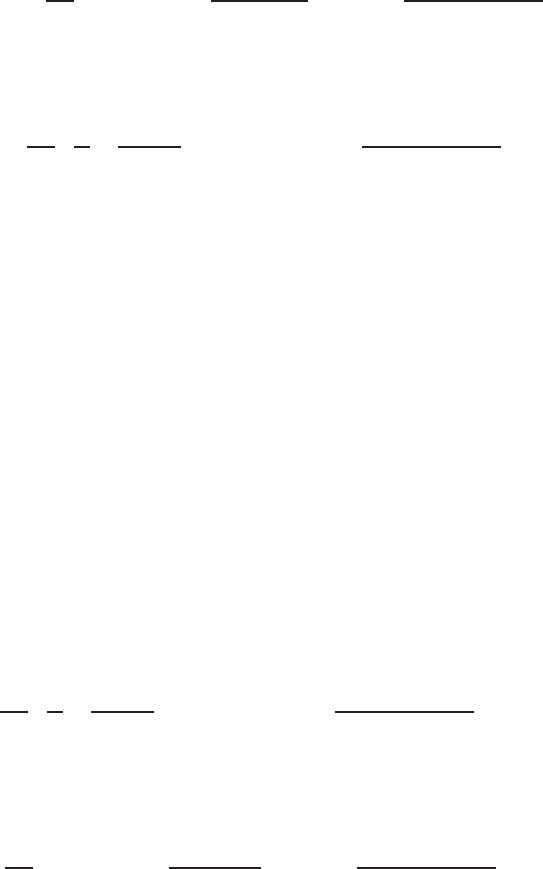
336 11 Electrical Images in Poten tial Theory
h) Expression of potential at a point when the current electrode is in mediu m
3 and the potential electrode is in medium 2
φ
3
2
=
ρ
2
I
4π
(1 + K
23
)
)
∞
n=0
(K
21
K
23
)
n
(2nH + D)
− K
12
∞
n=1
(K
21
K
23
)
n−1
(2nH + 2Z −D)
*
(11.21)
i) Expressions of potential at a p oint when both the electro des a re in
medium 3
φ
3
3
=
ρ
3
I
4π
)
1
D
−
K
23
2Z ± D
− (1 − K
23
)K
12
∞
n=1
(K
21
K
23
)
n−1
(2nH + 2Z ± D)
*
(11.22)
11.5 E x pressio ns for Potentials for Two Electrode
Configuration
For full space with two plane parallel boundaries there will be in total five
cases for two electrode configurations (Fig. 11.3) when target bed thickness
is greater than tool length. If target bed thickness is less than tool length a
special case arises (Fig. 11.3). In any set up the total number of tool p ositions
with respect to target bed are five. Expressions for Potential for different cases
are given below. For two-electrode configuration, the return current electrode
and other potential electrode are theoretically assumed at infinite distances. In
reality, they are kept away from the electrode system AM. Tool configuration is
shown in the Fig. 11.3 and AM (=D) is the electrode separation. Expressions
for potentials for five cases are
Cases for thick bed (H > L)
Case 1:
φ
M
ρ
1
I
4π
)
1
D
+
K
12
2Z − D
+(1− K
12
)K
23
∞
n=1
(K
21
K
23
)
n−1
(2nH + 2Z − D)
*
(11.23)
Case 2:
φ
M
=
ρ
2
I
4π
(1 − K
12
)
)
∞
n=0
(K
21
K
23
)
n
(2nH + D)
+K
23
∞
n=1
(K
21
K
23
)
n−1
(2nH + 2Z −D)
*
(11.24)
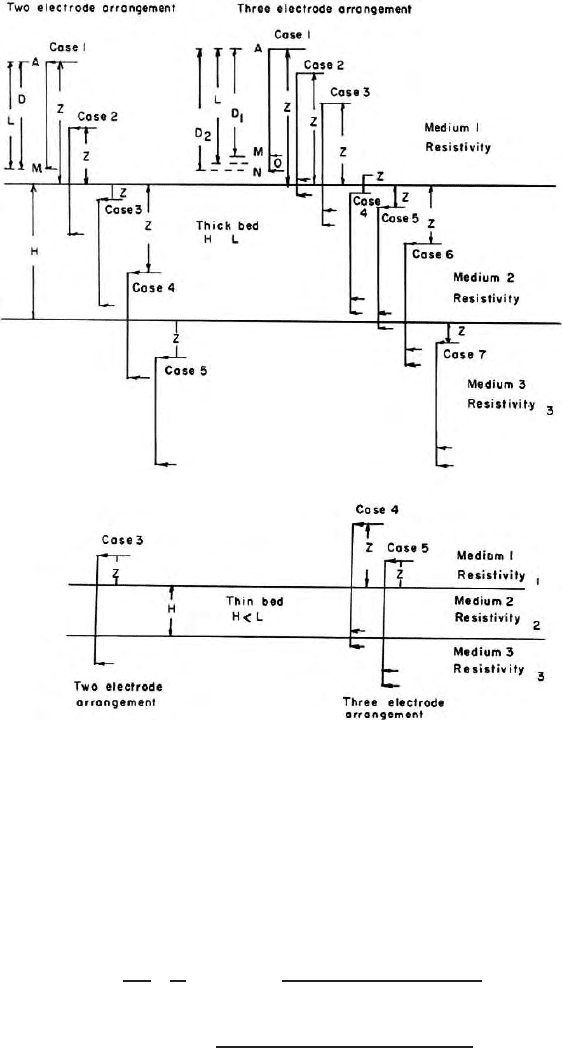
11.5 Expressions for Potentials for Two Electrode Configuration 337
Fig. 11.3. Three media with two plane parallel boundaries; first and third media
are semiinfinite media; second medium has finite thickness; two electrode (AM) and
three electrode (AMN) set up are approaching and crossing the two boundaries;
5 and 7 set of images are respectively formed as shown; thin bed case, i.e., bed
thickness less than the electrode separation are presented
Case 3
φ
M
=
ρ
2
I
4π
)
1
D
+K
21
∞
n=1
(K
21
K
23
)
n−1
{2(n− 1) H + 2Z + D}
+K
23
∞
n=1
(K
21
K
23
)
n−1
{2(n− 1) H + 2 (H − Z) − D}
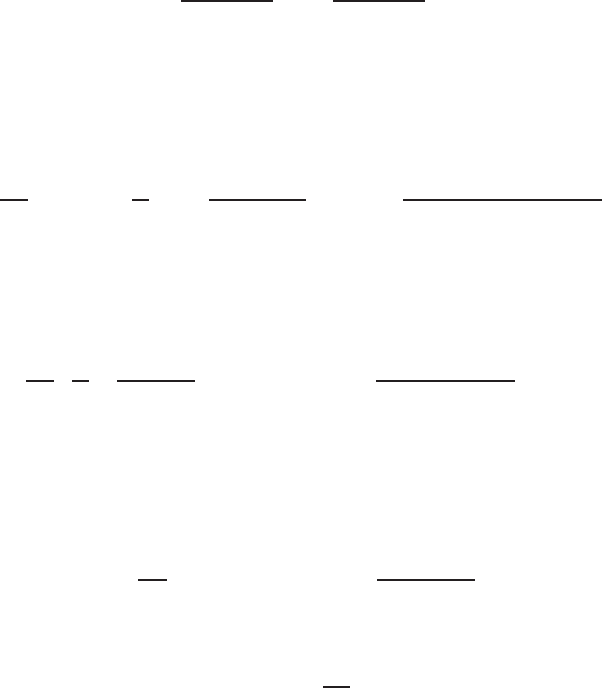
338 11 Electrical Images in Poten tial Theory
+
∞
n=1
(K
21
K
23
)
n
(2nH + D)
+
∞
n=1
(K
21
K
23
)
n
(2nH −D)
*
(11.25)
Relative tool po sitions for normal and lateral electrode
Case 4:
φ
M
=
ρ
3
I
4π
(1 −K
23
)
)
1
D
+
∞
n=1
(K
21
K
23
)
n
(2nH + D)
+K
21
∞
n=1
(K
21
K
23
)
n−1
{2(n− 1) H + 2Z + D}
*
(11.26)
Case 5:
φ
M
=
ρ
3
I
4π
)
1
D
−
K
23
(2Z + D)
− (1 −K
23
)K
12
∞
n=1
(K
21
K
23
)
n−1
(2nH + 2Z + D)
*
(11.27)
Sp ecial case for thin bed (H < L):
Case 3:
φ
M
=
ρ
3
I
4π
(1 −K
12
)(1− K
23
)
∞
n=0
(K
21
K
23
)
n
(2nH + D)
(11.28)
Apparent resistivity (ρ
a
) at each point of the run is computed using the for-
mula
ρ
a
=4π.AM.
φ
M
I
(11.29)
where, AM is the tool length and I is the current intensity.
11.6 E x pressio ns for Potentials for Three Electrode
Configuration
In case of lateral o r three-electro de arrangement, the total cases in any setup
are seven. Both thick bed (H > L)andthinbed(H< L) cases a re con-
sidered. The different positions including the special cases for thin bed are
shown in Fig. 11.3 Bed thickness less than potential probe separation (MN)
is not considered, as the separation is very less compared to to o l length. Tool
configuration is shown in Fig. 11.3 w h ere A is the current electrode and M,
